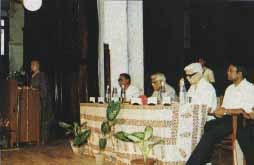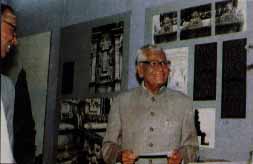A Glimpse into our Heritage”: Exhibition and a Seminar on Brhadisvara
Cultural studies should promote a complete experience of the life they choose to explore, by adopting an integrated method of research, rather than a fragmentary, one-dimensional approach. This is perhaps what came out of the exhibition and Seminar on Brhadisvara organised in Madras by the Janapada Sampada Division of IGNCA in the second week of October 1993. The exhibition and Seminar were part of a monumental study on the Brhadisvara temple conducted by IGNCA, which tries to record the living tradition surrounding the temple, including religion philosophy, history, social patterns, architecture, epigraphy, art and literature, dance and music and so on.
Shri R. Venkataraman at the Brhadisvara Exhibition
The Exhibition, titled Earth to Eternity was the out come of a multi-disciplinary project on Brhadisvara, a unique temple belonging to the 11th century. The exhibition highlighted the finest achievement of Chola art. On display were the architectural drawings of the temple, the different facades of the monument, Chola and Nayaka mural paintings, estampages of Raja Raja Chola edicts on the walls of the temple, Chola bronzes, coins and inscribed copper plates. The research and documentation for this was done by IGNCA in collaboration with Ecole Francaise D’Extreme Orient, Pondicherry. The exhibition, done in collaboration with Govt. Museum, Madras was widely covered by the press, as well as by All India Radio and Doordarshan. Side by side with the exhibition, there was a Seminar on ‘Brhadisvara: The Monument and the Living Tradition’ focussing on IGNCA’s multi-disciplinary research on the Brhadisvara project.
Both the Exhibition and Seminar on Brhadisvara were inaugurated by Sh. R. Venkataraman, former President of India. In the Presidential address, Dr. S. Gopal observed that “in its mass, scale, balance, symmetry and dimension, the Brhadisvara temple is second to none”. Dr. Kapila Vatsyayan, Academic Director, IGNCA welcoming the distinguished guests and participants, introduced the Brhadisvara project in which multi-disciplinary research is going on since 1988. She emphasized that the temple is not merely an archaeological structure, but is an important, living entity which has been preserved down the generations in a more or less intact form. The seminar, divided into three parts – Documentation, Perception and Interpretation – was attended by thirty scholars representing varied disciplines, such as Architecture, Epigraphy, Art History, Musicology, Dance, etc. Mr. P. Pichard spoke on the Brhadisvara temple architecture, while Mr. Anup Dave dwelt on the town and temple layout. Dr. Champakalakshmi offered the historical interpretation, Dr. R. Triumalai revealed the socio-economic conditions evident from Tanjore inscriptions. Dr. Padma Subrahmanyam spoke on the dance traditions associated with the Tanjore temple, and Shri B.M. Sundram threw light on temple music. The lectures were supplemented by Tevaram recitals, the screening of a film (based on IGNCA’s collection of Sadagopan’s films) on Kancheepuram Paramacharyal in Temple festivals, and dance demonstration by Tanjore Kittappa Pillai and his disciples. An Agama text Aghora Sivacharya Paddhati translated by Prof. S.S. Janaki was released on the occasion. The valedictory address was given by Shri T.V. Venkataraman, Chief Secretary of Tamil Nadu.
The exhibition was widely covered by the press and greatly appreciated by the visitors. Described as ‘a glimpse into our heritage’ and ‘a unique event’, the seminar and the exhibition underscored the importance of an integrated study on the cultural heritage of India.
In his inaugural address of the Seminar on Brhadisvara, Shri R. Venkataraman spoke on the need for an integrated study on the temple. Here are some excerpts from his speech:
nl00108h.jpg (10221 bytes)
The Temple is not merely a monument in stone. It was and is a living entity. In Chola times temples were assiduously built, fostered and maintained. The whole life of the community revolved around it. It conducted schools, housed a library, gave medical relief, shops and bazars sprang around thus it became the focus of the life of the community. Some temples had a dairy attached to them and milk was served to children either studying in the pathsala or in the neighborhood. The temple rituals and the fairs and festivals enriched the material and spiritual life of the community.
There can be no monument or project so worthy of an integrated study of the art forms and experiences as the Brhadisvara Temple. I congratulate the Indira Gandhi National Centre for the Arts and its dynamic Secretary Smt. Kapilaji on undertaking such a project and conducting a seminar of the diverse aspects with the help of scholars…
I am afraid that a project of this kind cannot achieve its aims by a mere data-collection and reproduction. Nor is it possible to bring out the integrity of the arts and above all the integrity of the symbolism and its content and of all human endeavour coevals with life.
There is a fundamental basis of our art and culture. They are embedded in the unity of life and seek to consciously ascend to the heights of experiences where the form and the concept completely merge and become part of the great Void. This is symbolized by rising power of the Brahadisvara temple.
[ Newsletter | List of Newsletter ]






